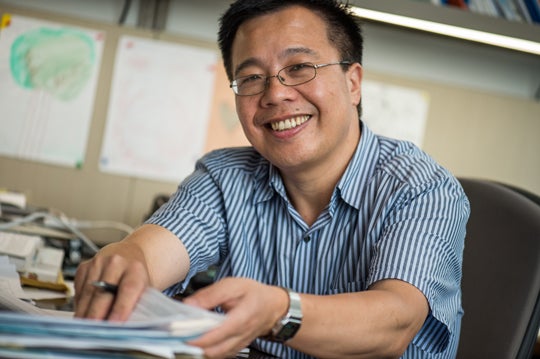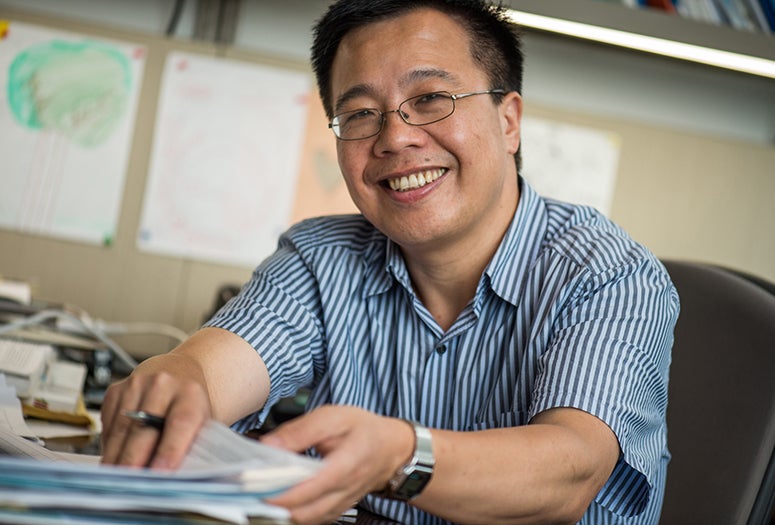Rice University physicists have shown that immutable topological states, which are highly sought for quantum computing, can be entangled with other, manipulable quantum states in some materials.

“The surprising thing we found is that in a particular kind of crystal lattice, where electrons become stuck, the strongly coupled behavior of electrons in d atomic orbitals actually act like the f orbital systems of some heavy fermions,” said Qimiao Si, co-author of a study about the research in Science Advances.
The unexpected find provides a bridge between subfields of condensed matter physics that have focused on dissimilar emergent properties of quantum materials. In topological materials, for example, patterns of quantum entanglement produce “protected,” immutable states that could be used for quantum computing and spintronics. In strongly correlated materials, the entanglement of billions upon billions of electrons gives rise to behaviors like unconventional superconductivity and the continual magnetic fluctuations in quantum spin liquids.
In the study, Si and co-author Haoyu Hu, a former graduate student in his research group, built and tested a quantum model to explore electron coupling in a “frustrated” lattice arrangement like those found in metals and semimetals that feature “flat bands,” states where electrons become stuck and strongly correlated effects are amplified.
The research is part of an ongoing effort by Si, who won a prestigious Vannevar Bush Faculty Fellowship from the Defense Department in July to pursue the validation of a theoretical framework for controlling topological states of matter.
In the study, Si and Hu showed that electrons from d atomic orbitals could become part of larger, molecular orbitals that are shared by several atoms in the lattice. The research also showed that electrons in molecular orbitals could become entangled with other frustrated electrons, producing strongly correlated effects that were very familiar to Si, who has spent years studying heavy fermion materials.
“These are completely d-electron systems,” Si said. “In the d-electron world, it’s like you have a highway with multiple lanes. In the f-electron world, you can think of electrons moving in two tiers. One is like the d-electron highway, and the other is like a dirt road, where movement is very slow.”
Si said f-electron systems host very clean examples of strongly correlated physics, but they aren’t practical for everyday use.
“This dirt road lies so far from the highway,” he said. “The influence from the highway is very small, which translates to a minute energy scale and very low-temperature physics. Meaning you need to go to temperatures around 10 Kelvin or so to even see the effects of coupling.
“That is not the case in the d-electron world. Things couple to one another quite efficiently on the multilane highway there.”
And that coupling efficiency persists, even when there is a flat band. Si likened it to one of the highway’s lanes becoming as inefficient and slow as the f-electron dirt road.
“Even when it has faded into a dirt road, it still shares status with the other lanes, because they all came from the d orbital,” Si said. “It is effectively a dirt road, but it is much more strongly coupled, and that translates to physics at much higher temperatures.
“That means I can have all of the exquisite, f-electron-based physics, for which I have well-defined models and a lot of intuition from years of study, but instead of having to go to 10 Kelvin, I can potentially work at, say, 200 Kelvin, or possibly even 300 Kelvin, or room temperature. So, from a functionality perspective, it is extremely promising.”
Si is the Harry C. and Olga K. Wiess Professor of Physics and Astronomy at Rice, a member of the Rice Quantum Initiative and director of the Rice Center for Quantum Materials (RCQM).
The research was funded by the Department of Energy (SC0018197), the Air Force Office of Scientific Research (FA9550-21-1-0356), the Welch Foundation (C-1411) and received support through computational and visiting facilities by the National Science Foundation (1607611, 0216467, 1338099, DMR160057).
- Peer-reviewed paper
-
“Coupled topological flat and wide bands: Quasiparticle formation and destruction” | Science Advances | DOI: 10.1126/sciadv.adg0028
Authors: Haoyu Hu and Qimiao Si
- Image downloads
-
https://news-network.rice.edu/news/files/2023/07/0724_BUSH_qmsi-lg.jpg
CAPTION: Quantum physicist Qimiao Si is Rice University’s Harry C. and Olga K. Wiess Professor of Physics and Astronomy and director of the Rice Center for Quantum Materials. (Photo by Jeff Fitlow/Rice University) - Related stories
-
Rice researchers earn prestigious Defense Department grants – July 20, 2023
https://news.rice.edu/news/2023/rice-researchers-earn-prestigious-defense-department-grantsPhysicists use ‘electron correlations’ to control topological materials – Oct. 11, 2022
https://news.rice.edu/news/2022/physicists-use-electron-correlations-control-topological-materialsPhysicists demo method for designing topological metals – Sept. 15, 2022
https://news.rice.edu/news/2022/physicists-demo-method-designing-topological-metals - About Rice
-
Located on a 300-acre forested campus in Houston, Rice University is consistently ranked among the nation’s top 20 universities by U.S. News & World Report. Rice has highly respected schools of Architecture, Business, Continuing Studies, Engineering, Humanities, Music, Natural Sciences and Social Sciences and is home to the Baker Institute for Public Policy. With 4,240 undergraduates and 3,972 graduate students, Rice’s undergraduate student-to-faculty ratio is just under 6-to-1. Its residential college system builds close-knit communities and lifelong friendships, just one reason why Rice is ranked No. 1 for lots of race/class interaction and No. 4 for quality of life by the Princeton Review. Rice is also rated as a best value among private universities by Kiplinger’s Personal Finance.

